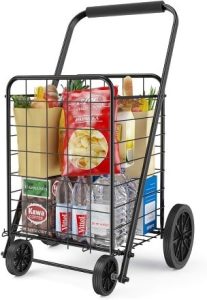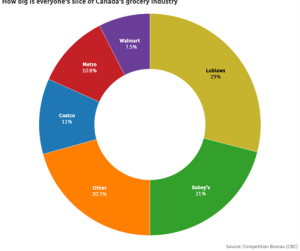Boycotting Loblaw’s
A friend of mine mentioned in an email that there was a boycott of Loblaw’s going on. News to me, but hey, there’s that internet thing, so I started searching, and sure enough, there is. A Reddit group called r/loblawsisoutofcontrol is pushing a boycott of all Loblaw’s owned retail outlets in May.

Here’s the statement on the Reddit site:
“Our community has taken the time to organize a movement which aims to boycott Loblaw stores until prices can be reduced.
Since it’s founding, our community has seen hundreds of ridiculously priced goods, dumb deals, rotten produce and more. Loblaw, and other major grocers in Canada enjoy the benefits of a monopoly on an essential service, and force us to pay utterly ridiculous prices. Canadians are facing a cost of living crisis, and grocers are a major contributor to this. Vunerable populations such as seniors, persons with disabilities, and those on fixed incomes are left further behind. Food banks across the country are seeing a drastic increase in demand.
In response, our team has organized a boycott of Loblaw stores and demand action in order to provide relief to Canadians.”
The first thing I wondered about this was – why Loblaw’s, and not, say Metro or Sobey’s? If the group believes that prices are generally higher at Loblaw’s outlets than at those other places, then a campaign to buy from the other places rather than Loblaw’s is what used to be called ‘shopping’. Buy low is a good strategy, I reckon, not a movement in need of a reddit group.
On the other hand, the statement also says “Loblaw, and other major grocers in Canada enjoy the benefits of a monopoly on an essential service, and force us to pay utterly ridiculous prices.”
If there is more than one grocer, then nobody has a monopoly on anything, but it is true that the grocery industry in Canada is pretty concentrated, by which I mean that a few corporations sell most of the goods.
Below, courtesy of CBC, is a look at how revenues in the grocery industry in Canada are distributed. What that graphic doesn’t make clear is whether the Loblaw’s share of 29%, the largest, included sales of all the outlets the company owns. That is, are grocery sales from Shoppers and The Real Canadian Superstore, etc, included in the Loblaws number, or are those sales in the Other category.
Anyway, even if the ‘other’ category really is other, it seems that Loblaw’s, Metro, Costco and Sobey’s are the four big guns, and an industry in which the four largest sellers earn 72% of all sales revenue is pretty damn concentrated. An oligopoly, for sure. This is, btw, a problem in many industries in Canada, and one that has been commented on constantly by smarter people than me. Banking, airlines and other industries are also highly concentrated in Canada, and more importantly, perhaps, they have been becoming more so in the last decade or so. This trend toward higher concentration extends to our neighbours to the south, also.

Economists say many complicated things about competition, but on the ground it is about choices. If you, as a consumer, have a lot of choices as to where to buy something, that market is competitive, and so the more concentrated is an industry, the less competitive it is, on that measure. By the same measure, it was surely a mistake for the Canadian Competition Bureau to let Loblaw’s buy up most of Shopper’s Drug Mart back in the day, and more recently for Sobey’s to be allowed to buy Farmboy, just as it was a mistake to let ScotiaBank buy up Ing bank and turn it into Tangerine.
Of course, the grocery business could be worse: there isn’t actually a monopoly seller. If Loblaw’s were that, no boycott would be possible and a monopoly Loblaw’s really would have control of an essential service.
There is also no doubt that grocery prices have risen faster than prices in many sectors in the recent inflationary period – that you can look up. One explanation for this could be as follows. We got inflation in Canada (as in the US and other countries) from 2022 forward in part because the Government threw piles of money at people during the pandemic, but there wasn’t a lot to spend it on during lockdowns. Once those were lifted, folks had lots of savings they wanted to spend, and firms’ attempts to meet this increased demand were somewhat stymied by supply-chain difficulties. So, you get good-old demand-pull inflation. The supply chain issues by now are mostly gone, but it is still true that increasing the supply of food in response to increasing demand can’t happen fast: crops, produce and cattle don’t come to market in a day, so there are still demand-pull issues in groceries. So, grocery prices are still rising faster than other prices.
I wouldn’t stake a million bucks on that explanation, but it’s not implausible, either.
Which returns me to the Loblaw’s boycott and my original question: why them? Is it a fact that prices have gone up more at Loblaw’s than at Sobey’s or Metro? If so, then we are back to ‘shopping’ and I’m not going to argue against shopping for lower prices. But if not, if prices have risen over the last two years about the same amount at all the major grocery stores, then I will hypothesize that Loblaw’s is the target largely because Galen Weston is so much in the news. Galen maybe needs to keep a lower profile.
A final note. Crack economist Jagmeet Singh was quoted recently in The National Post as follows: “We know the major driver that is driving up the cost of living is corporate greed….” (ellipsis in the original NP article).
Based on Singh’s deeply insightful analysis, reducing inflation in Canada shold not be hard. Just replace all our corporation heads with the ones that were on the job before 2022, as those folks were clearly not greedy – inflation in all sectors was microscopic back in those good-old days.
Don’t you love simple answers?